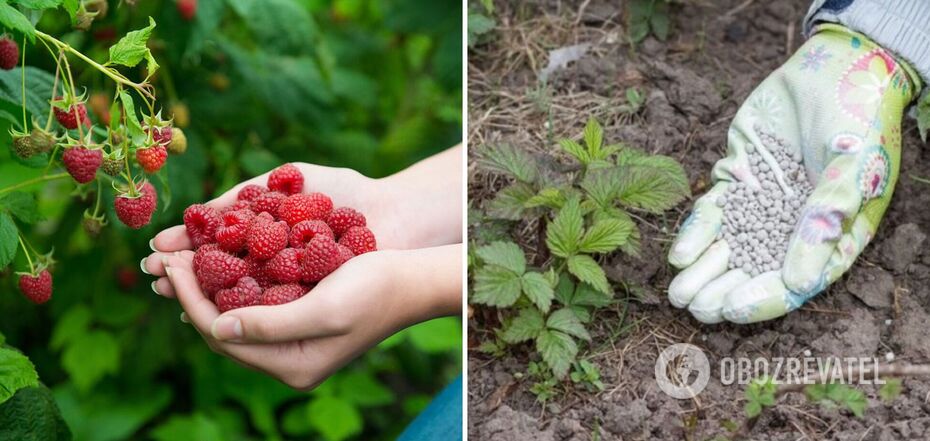Life
How to fertilize raspberry bushes in spring for a great harvest: tips
Raspberries are a plant that ages quite quickly. At the age of 2-3, the bush begins to weaken and yield less. In this case, it begins to grow in breadth to find richer and more fertile soil for new shoots. To maintain raspberry health and yield, the plant needs to be properly fed in the spring.
OBOZREVATEL has learned the ins and outs of fertilizing raspberries. A properly treated bush will bring a good harvest, and the berries will be larger and sweeter.
Nitrogen fertilizer
Adding nitrogen to the soil in the spring is very important because this substance helps plants form a healthy leaf mass. The dosage should be quite precise, as excess nitrogen can interfere with raspberry flowering and, consequently, the appearance of berries. Also, an overdose of fertilizer can seriously damage the plants.
Nitrogen can be applied from the moment the snow melts until the leaves are fully developed. Ideally, this should be in March, if it is snowless. Poor soils (clay and sandy) can be fertilized with nitrogen twice during this period. If the plant starts to grow and develop actively after the first application, it means that the nitrogen it received is enough.
The easiest way to apply nitrogen is to scatter this mineral fertilizer on the melted snow, so it dissolves in water and naturally falls into the ground. When you see a puddle of water with small islands of snow under the raspberries, it's time to feed them with nitrogen. You shouldn't sprinkle nitrogen on stable snow or ice, as it will evaporate when it melts and not go into the soil.
Another reliable method is to apply nitrogen fertilizer when the raspberries begin to appear. At this time, the plant actively absorbs nutrients from the soil and absorbs them well.
If you are growing remontant raspberries and cut off all their branches in the fall, it is better to postpone fertilizing until late March or April. But it's better to do it before the first leaves appear. This way it will be better saturated with nitrogen.
Nitrogen fertilizers include urea and ammonium nitrate. You can also apply compound fertilizers, which contains nitrogen, phosphorus, and potassium at the same time. In this case, you will have to reduce the concentration of nitrogen and phosphorus during the summer fertilization of raspberries. The application rates for these fertilizers are as follows:
- urea - 15-20 g per square meter;
- ammonium nitrate - 10-15 g per square meter;
- compound fertilizers - 20-30 grams per square meter.
How to properly fertilize raspberry bushes
If you have chosen the method of scattering fertilizer on the ground, try to distribute the product evenly, and then loosen the soil around the bush to a depth of about 5 cm so that the granules are mixed with the ground. If the substrate under the bushes is dry, you need to water it additionally.
You can also apply mineral fertilizers dissolved in water. It is better to take a little less substance than the instructions suggest, and after fertilizing, spill the soil with water on top so that nitrogen penetrates deeper into the roots and does not simply evaporate.
Organic fertilizer for raspberries
Organic fertilizers are another rich source of nitrogen. They also contain potassium, phosphorus, and other trace elements. However, their concentration is quite difficult to calculate, because each time the mixture is obtained with a different proportion of components. Here are the fertilizers you can use for raspberries.
One year or more of humus
Calculate humus in the proportion of 1 bucket per square meter. It should be scattered on the ground and mixed with its top layer in any way. Fresh humus is not suitable for fertilizing raspberries.
Infusion of cow or horse manure
To prepare a liquid manure-based fertilizer, fill a bucket one-third full of dry matter and then add water to the top. Next, cover the bucket with a lid and put it in a warm place to stir. Open and stir the product daily. After about 5-7 days, the mixture should be diluted with water in a ratio of 1:10 and poured over the raspberries at the rate of a bucket per square meter.
Infusion of bird droppings
This remedy is made and applied to the ground in the same way as the previous one. But you need to dilute it twice as much for application - in a ratio of 1:20.
Infusion of weeds or nettles
To prepare a plant-based liquid fertilizer, you need to take the succulent parts of the plants, grind them, fill a container with them and pour water over them. This infusion should ferment for 7-10 days. It should be stirred daily. The finished liquid is diluted with water in a ratio of 1:5 and raspberries are watered with it at the rate of a bucket per square meter.
Siderata plants
In the spring, sow legumes (peas, clover, lupine) in the garden between rows. These plants themselves attract nitrogen to the upper layers of the soil. And their green mass can be used to make a liquid fertilizer rich in this substance. When the green manure buds, they should be mowed and spread between the rows. In the process of decay, they will enrich the soil with macro- and micro fertilizers.
Earlier, OBOZREVATEL revealed how to prune currants and gooseberries, so they give a great harvest.
Subscribe to the OBOZREVATEL channels on Telegram and Viber to keep up with the latest news.



























